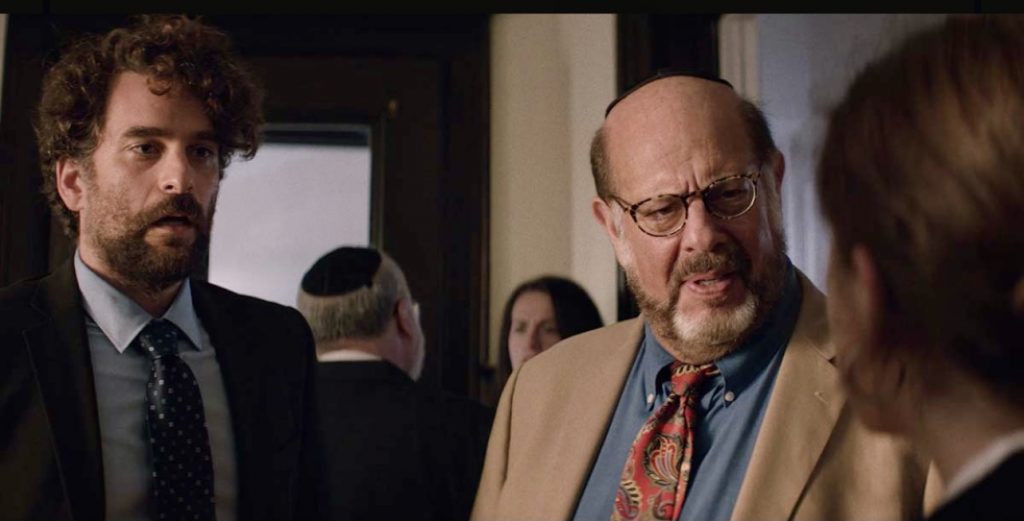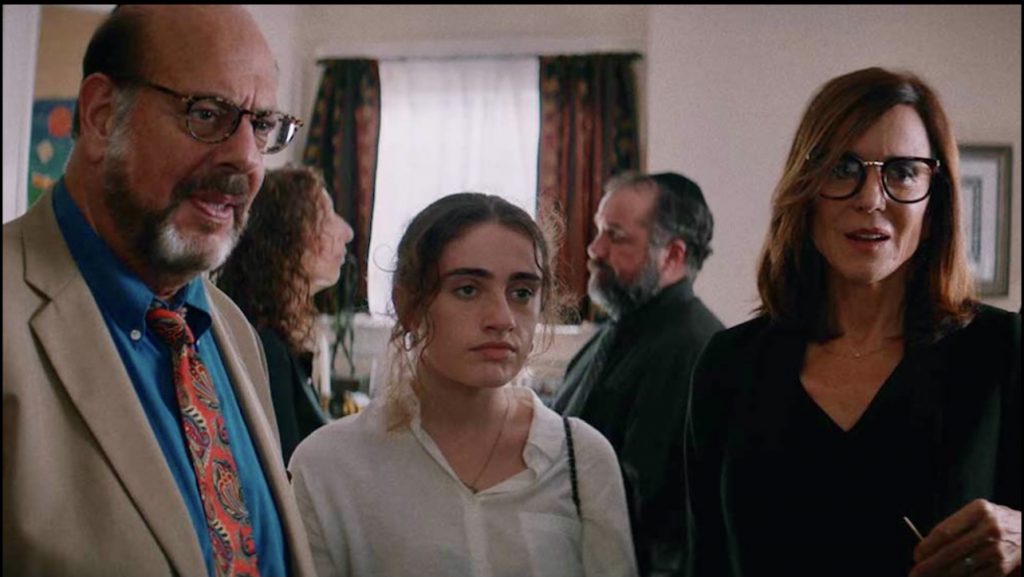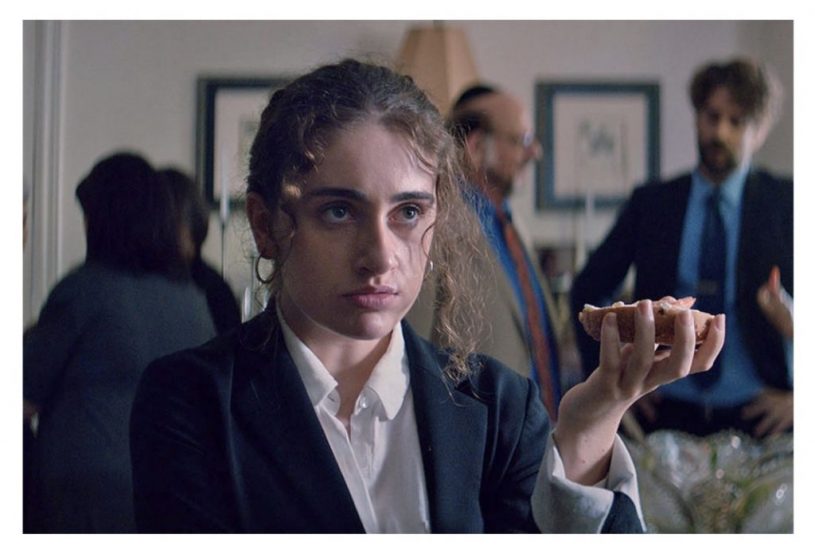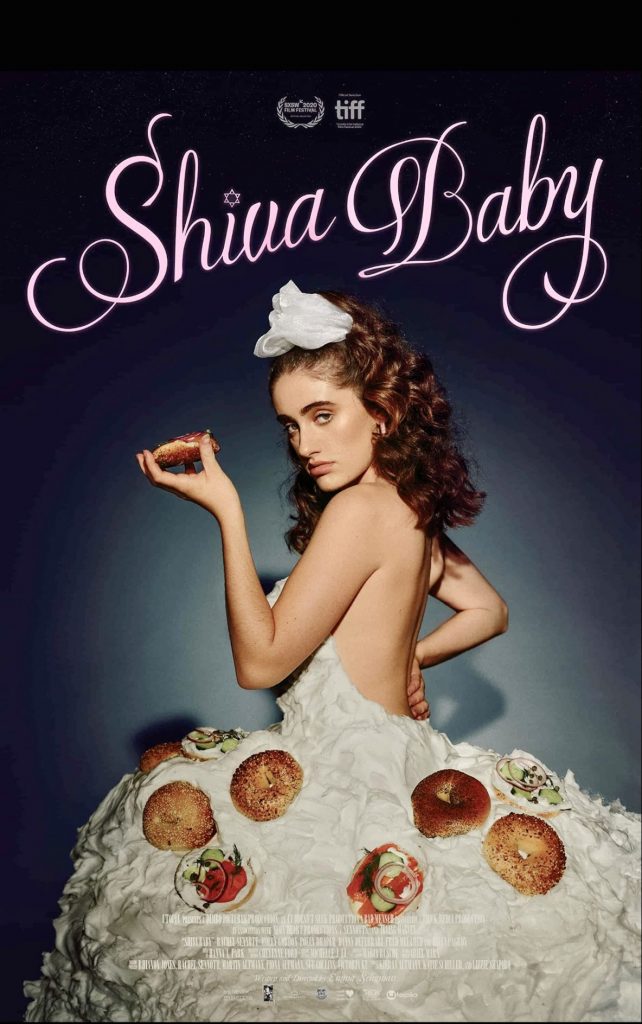‘Uncomfortable Comedy’: A Q&A With ‘Shiva Baby’ Writer-Director Emma Seligman
After racking up runner up nods in the Best Narrative and Best First Film categories at last fall’s Out on Film festival, Writer-Director Emma Seligman’s hilarious “Shiva Baby” returns to Atlanta this weekend virtually as part of the 2021 Atlanta Jewish Film Festival.
The film stars Rachel Sennott (now appearing weekly on the new Kyra Sedgwick ABC sitcom “Call Your Mother”) as Danielle, an anxious, soon-to-be college graduate who somehow ends up at a Jewish funeral service with her parents, her sugar daddy and her ex-girlfriend all sprinkled among the lox, bagels and crying babies.
Inspired by Seligman’s own 2018 short film, “Shiva Baby” has steadily grown its fan base with screenings (mostly virtual, due to COVID) at SXSW, the Toronto Film Festival, Outfest (where Seligman scored the Best Screenwriting award) and the Philadelphia Jewish Film Festival where Sennott took home the Rising Star award.
In addition to an outdoor screening Feb. 25 at AJFF’s Young Professionals Night as part of the festival’s Drive-In series at Mercedes-Benz Stadium, “Shiva Baby” is now available to watch virtually this weekend until Monday at noon.
At last fall’s virtual Out on Film festival, Eldredge ATL had an opportunity to moderate a Q&A with writer-director Seligman and her former NYU classmates, “Shiva Baby” producers Katie Schiller and Kieran Altmann. Below is an edited version of that conversation.
Q: This film started life as an eight-minute short. How did you make the transition to the feature?
Emma Seligman: I made the short in my senior year at NYU. I was in classes with Katie and Kieran at the time. For my thesis, I wanted to do something I could speak confidently to. I didn’t want it to be out of this world and crazy. So I set it at a Jewish family function. At the time I was feeling really uncomfortable about my self-worth and my future. There was a lot of anxiety coming from different places in my life. A lot of my friends were sugar babies and I was dealing with a lot of thoughts about sexual self-worth. So I channeled all these feelings into an uncomfortable comedic short film. I didn’t think too intently about what it meant because it was a short. I just wanted it to be funny and uncomfortable. And then the short got into SXSW two years ago. I convinced Katie and Kieran (none of us had ever made a feature) to go on this wild ride with me. We were able to keep the budget small because we shot it in one house and the film takes place over the course of one day.
Q: Katie and Kieran, what persuaded you to take that ride with Emma?
Katie Schiller: Going to NYU with her, I was such a fan of Emma’s and we were friends as well. The short was so brilliant that when she approached me and said, “Hey, I actually wrote a feature-length version. Would you read it?” The material just spoke for itself. I just knew I wanted to be a part of it.
Kieran Altmann: Emma and I had studied abroad earlier on so I was very aware of her screenwriting capabilities. I saw the short film and knew how amazing it was. I happened to be Katie’s roommate when she read the feature-length script. We all had a great personal relationship that set the foundation for a great working relationship.
Q: Emma, you cast Rachel Sennott as Danielle in both the short and the feature. After seeing the film, I can’t picture anyone else playing the role. It appears you felt the same way?
Seligman: Yes, I did. I was really intent on keeping Rachel from the short to the feature. I learned through this process this is not something that happens frequently. Usually, roles are recast with someone who is more recognizable or who has more credits. Everyone supported me in the vision because Rachel really made the short what it was. Originally, the short was supposed to be much more dramatic before she came onboard. Rachel just put her own stamp on it. There was no way we were going to do it without her.
Q: Beneath its humor, this film has so many important messages for young people. It’s female-driven, it’s sex positive, it’s funny and it tracks a young woman in really uncertain times when many young people don’t know what the future holds for them. Can you talk a little about creating the complexities of Danielle?
Seligman: I took a lot of feelings I was experiencing. They all kind of just vomited out of me. And when I did the feature, it was a bit like psychoanalysis of where I had been before. All of the things that were closing in on me. I can’t even begin to imagine what it feels like now with all of the additional challenges young people are facing with COVID. At the time, I just felt insane pressure from my family and my community to have a stable career. But I also felt pressure about going to art school and being in New York and being a sexy, independent woman. I also felt like my ability to have power from sexual validation was totally going away and I was having a panic attack. I just tried to make the worst version of all those feelings and pack them all into a single day for this character. A character who was somehow even more insecure and self-loathing with the most neurotic, crazy parents. I took everything to extremes and took it as far as I could without making it hokey. I just tried to make her a horrible, horrible version of my worst qualities!
Q: Katie and Kieran, you get to wear a lot of hats when you produce a small budget indie feature. What were your roles during the shoot?
Altmann: Not only were we on-set we essentially lived on set during the shoot. The room we were living in was also the room we used for wardrobe and hair and make-up and it served as the production office as well. We had a pull out bed that Katie and I slept on every night during filming. It was a way to minimize securing the film gear every night while maximizing getting the greatest amount of sleep possible.

Schiller: At times, it became an outer body experience (laughs). But we really wanted to put as much of the money on screen as possible. Therefore, we took it upon ourselves to do as much of the work as our skills sets would allow. We shot in New York in August so that meant even doing things like turning on and off all of the air conditioners before and after every take. When you watch the film, you can see that, at times, there were as many as 50 people in that house, including all the background people., cast and crew with lots of hot lights.
Altmann: The beautiful thing is because we were shooting in the same house together every day there’s this energy that was captured. It almost felt like we were all living together at the shiva. It all translates into the comedy, awkwardness and the stress on screen.
Q: We’re in Danielle’s shoes — and her ripped tights — throughout the film. The audience experiences that same claustrophobia as Danielle as her life closes in on her. What were some of the challenges filming in a real house with walls and ceilings and all those extras?
Seligman: It’s tough to maintain that level of claustrophobia throughout a feature film. The biggest challenge for us was finding new ways to put her in that situation.

Q: This is an ensemble film with wonderful actors. It doesn’t get better than Polly Draper’s performance as Danielle’s mother. How were you able to secure these folks?
Seligman: We worked with a great casting director, Kate Geller who really fought for us. She wanted to draw from the New York Jewish film community. I was a big fan of Polly Draper’s from “Obvious Child” and my mom was a fan as well from “Thirtysomething.” We just sent offers and I was so shocked when people said yes. People like Jackie Hoffman said yes! It was a combination of people I had dreamed of, combined with Kate’s recommendations. Everyone we got ended up having a personal connection to the material, even if they weren’t Jewish. Having the short film also showed them the proof of concept and I think that helped us. It helped them trust me a little more.
Q: Ariel Marx’s score in this film is perfection. Thanks to her, your heart rate goes up as you watch Danielle’s various calamities unfold. How did that come together?
Seligman: Before shooting the film, I was pretty convinced I didn’t want a score. I don’t know what I was thinking. But then, when we were shooting, I began to see visually how the scenes would play in the edit and I knew I wanted something to further heighten Danielle’s anxiety. We ended up meeting Ariel from a former student of a mutual professor and she was wonderful. I knew I wanted something string-based, one, because it was reflective of a horror score and two, I wanted something klezmer-inspired, that had vibes of “Fiddler on the Roof.” Ariel had to take all of my wacko references and blend them all together!
Q: Young queer people will see themselves represented both on camera and in the screenplay of this film. Emma, what advice do you have for young queer filmmakers who may have a screenplay like yours on their laptop?
Seligman: To write as honestly as possible. It felt really important to me for this to be a bisexual story. It presented challenges because the entire film takes place in a day so the challenge was how do I show the full spectrum of Danielle’s sexuality? I had to ask, “How much can we get away with in one day at a family event?!” But there was no way we were going to do this movie without that. The more specific the story and the more specific the perspective is, the more universal the themes and the story becomes. We always talked about wanting to reach a queer audience and also a Jewish audience. But I’ve been so shocked that it’s reached people who aren’t queer, who aren’t Jewish, who are young or maybe anxious about the future. Even if you think your perspective is very specific, there’s going to be a universality connecting it other people’s stories.
“Shiva Baby” screens as part of AJFF’s Virtual Cinema series beginning at noon, Friday, February 19, 2021 until noon on Monday, February 22. It will screen outside as part of the festival’s Drive-In series on Thursday, February 25. For more details, go to ajff.org.

Richard L. Eldredge is the founder and editor in chief of Eldredge ATL. As a reporter for the Atlanta Journal-Constitution and Atlanta magazine, he has covered Atlanta since 1990.





